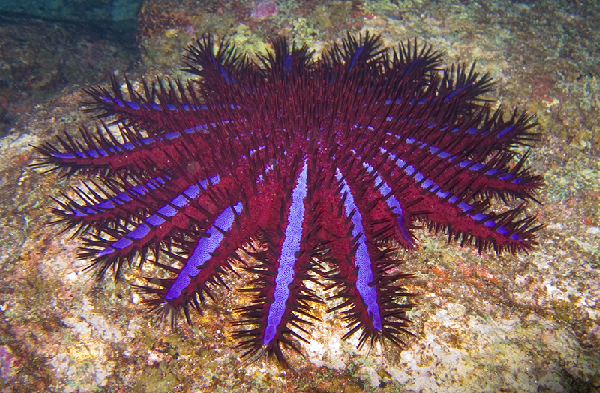Japanese Intensify Fight Against Reef Destroying Crown-of-Thorns Starfish
| Paula Marie Navarra | | Oct 12, 2014 11:39 PM EDT |
A new study published in the journal, Marine Biology, confirms the danger of unabated population growth among crown-of-thorns starfish, the greatest destroyer of coral reefs.
The crown-of-thorns starfish (Acanthaster planci) is an aggressive predator of scleractinian or the hard corals responsible for building coral reefs. The population increase of this voracious predator is of great danger to reefs because A. planci continually eats large areas of coral colonies.
Like Us on Facebook
Surges in the A. planci population devastate entire reef habitats. Such habitats are important as key tourism sites for the Ryukyu Islands in Japan.
The study published in Marine Biology is one of the longest and most extensive surveys of its kind, with data covering over 24 years. It was conducted in cooperation with the local fishing population of Onna Village in Okinawa and the Okinawa Institute of Science and Technology Graduate University or OIST.
OIST researchers were able to plot with a high degree of accuracy the movement and population size over time of A. planci with fisherman providing a great deal of logistics support and data.
The study analyzed the population dynamics of A. planci over time and examined potential factors that might sustain such populations off the Onna village coast. Data was gathered between July and August, the peak time for larval dispersal of A. planci.
The study found the majority of individual A. planci caught off Onna village fit within a certain size and age range. This suggests there is a relatively steady number of new A. planci coming in from elsewhere.
Recruitment rate refers to the number of new starfish entering an area as larvae or juveniles. The collection data also points population densities heading northward along the Onna village coastline.
Researchers hope is their work will provide the foundation for a better understanding of how and where population outbreaks of A. planci occur.
"This research is a first step. Now we are doing more detailed research to help conservation efforts. But we could not have done as much as we have without the help of the local fisherman who know the sea here better than anyone," said Masako Nakamura, a researcher at OIST's Marine Biophysics Unit that heads the joint effort.
To date, researchers are conducting further studies about ocean movements in the area and other environmental factors that might cause the starfish recruitment.
They hope this study will provide a better understanding about how starfish outbreaks occur in Japan.
They said this is just the first step and that they're now focusing on conducting more detailed research.
©2015 Chinatopix All rights reserved. Do not reproduce without permission
EDITOR'S PICKS
-

Did the Trump administration just announce plans for a trade war with ‘hostile’ China and Russia?
-

US Senate passes Taiwan travel bill slammed by China
-

As Yan Sihong’s family grieves, here are other Chinese students who went missing abroad. Some have never been found
-

Beijing blasts Western critics who ‘smear China’ with the term sharp power
-

China Envoy Seeks to Defuse Tensions With U.S. as a Trade War Brews
-

Singapore's Deputy PM Provides Bitcoin Vote of Confidence Amid China's Blanket Bans
-

China warns investors over risks in overseas virtual currency trading
-

Chinese government most trustworthy: survey
-

Kashima Antlers On Course For Back-To-Back Titles
MOST POPULAR
LATEST NEWS
Zhou Yongkang: China's Former Security Chief Sentenced to Life in Prison

China's former Chief of the Ministry of Public Security, Zhou Yongkang, has been given a life sentence after he was found guilty of abusing his office, bribery and deliberately ... Full Article
TRENDING STORY

China Pork Prices Expected to Stabilize As The Supplies Recover

Elephone P9000 Smartphone is now on Sale on Amazon India

There's a Big Chance Cliffhangers Won't Still Be Resolved When Grey's Anatomy Season 13 Returns

Supreme Court Ruled on Samsung vs Apple Dispute for Patent Infringement

Microsoft Surface Pro 5 Rumors and Release Date: What is the Latest?










